|
72
Secret Arts of the Shaolin Temple

Note:-
I will not be held responsible for any injuries or suffering if
anyone tries any of these techniques. All of these techniques
require special guidance from a qualified instructor. I doubt
you will find many instructors that know any of these techniques
as they are very old techniques and are only usually taught to
special students with high potential , respect and patience.
- Four Steps Arts
- Iron Head Arts
- Arhat Arts
- Iron Arms Arts
- Double Key Arts
- Pot Lifting Arts
- Key Stone Arts
- Iron Bag Arts
- Thousand Catties Floodgate Arts
- Whip Strength Technique
- Separating Water Arts
- Jade Belt Arts
- Embrace Tree Arts
- Eagle Wings Arts
- Overlord Elbow Arts
- Saddle Arts
- Pellet Fist Arts
- Gang Rou Arts
- Sand Bag Arts
- Sunlight Hands Arts
- Yin Fist Arts
- Iron Sands Palms Arts
- Bambo Leaf Hands Arts
- Pushing Mounts Palms Arts
- Close Plate Palms Arts
- Mantis Claw Arts
- Guan Yin Palms Arts
- Five Poison Hands Arts
- Cinnabar Palms Arts
- Single Finger Jin Gang Arts
- Immortal Palms Arts
- Touching Stone Arts
- Pipa Arts
- Pulling up Nails Arts
- Lifting up Thousand Catties Arts
- Rubbing and Inserting Arts
- Removing Mountains Arts
- Eagle Claw Power Arts
- Key Fingers Arts
- Single Finger Hand Stand Arts
- Picking up Flower Arts
- Centipede Leaping Arts
- Lying Tiger Arts
- Tortoise Back Arts
- Door Crotch Arts
- Iron Cow Arts
- Gunny Bag Arts
- Inhaling Yin Arts
- Soft Bone Arts
- Iron Broom Arts (Iron Legs Gong)
- Cypress Stake Arts
- Iron Knee Arts
- Foot Shooting Arts
- Self Hitting Arts
- Somersault Turning Arts
- Anti-Broadsword and Anti-Spear Arts
- Stone Pillar Arts
- Plum Blossom Stakes Arts
- Meteor Stakes Arts
- Leaping and Jumping Arts
- Jumping and Leaping Arts
- Flying Arts
- Light Body Arts
- Single Rope Penetrating Arts
- Penetration Arts
- Belt Somersault Arts
- Gecko Creeping Wall Arts
- Arts of Leaping onto Roofs and Vaulting
Over Walls
- Frog Arts
- Iron Shirt Arts
- Golden Clock Arts
- Swimming Skill Arts
1. Four Steps Arts
2. Iron Head Arts
Coil soft silk around your forehead about ten
times. Now wrap one or two iron pieces around your forehead on
the outside (you could use something like chain mail etc). Bump
your head against a wall two times only each day. While training
you MUST lift your Qi to fill your brain. At first do not over
exert force otherwise you will damage you not so tough skull.
Gradually over time bump the wall with your head a bit harder.
Slowly increasing the force. After more than one year later use
seven or eight pieces of silk instead of ten. Then after
hundreds of days more practice, decrease the silks to four of
five rounds. One more year later you can bump the wall without
using silk. It is very painful for a trainee to bump their head
straight against a wall but step by step your head should now be
as hard a brick. One must first cultivate one’s character
before practicing this skill.
3. Arhat Arts
There are a few ways of doing this exercise.
Shut your eyes while waking up. Massage them
gently with your thumbs fourteen times. Keep your eyes closed
and rub them from left to upper-right, to upper-front, then to
downward-right. Then from right to upper-right to right and
downward-right. Then from downward-right to downward-front , to
downward-left and then to the left. Do this seven times. After
massaging your eyes leave them closed for at least a few minutes
and then open them wide suddenly. Silence while doing this
exercise is essential. Use the back curvy bone of the thumb to
press the small acupoint (Zhuan-Zhu Acupoint) in the tip of the
eyebrow. Do this seventy two times. Then rub the cheekbones with
your hands rotating the Eardrop Acupoint for thirty six times.
Rub the forehead in the reverse direction, beginning in the
middle of the eyebrows towards the back of the head for seventy
two times (se your fingers to massage like you would when your
washing your hair). By doing this you will find that your
swallowing lots of saliva. Now paste a light green piece of
paper onto a windlamp which is burnt with sesame oil, and the
flame of which must be small. Put the lamp in a dark room. Stand
away from the lamp about 6 metres away, cross your legs and sit
on a bench using intense concentrating of your will. Withhold
your Qi and watch your lamp intently for about fifteen minutes.,
then close your eyes making your eyeballs rotate around thirty
six times (from left to right). Now rotate thirty six times in
the opposite direction (from right to left) . Now open your eyes
wide again and watch the lamp intently. Five to ten minutes
later close your eyes again and pactice the the "Open-Close
Eyes Arts" on the left and right, then vice versa. Each
night, practice for about two hours. After three months you can
deepen the colour of the windlamp paper a bit and the position
of the lamp can go back further by about half to one metre away.
Gradually over time you can deepen the colour of the paper from
light green to dark green and the lamp can eventually go back to
33 metres away. The size of the flame at this distance will be
the size of a small bean. You should now be practicing for about
four hours in total. When you have practiced this for a while
you will be able to see people / things in the dark up to 33
metre away. If you perfect your "jujube" ( the symbol
of eyes), you can gain extra advantage in combat. Eating sheep
liver will also increase your internal energy which will help
your vision / eye sight.
4. Iron Arms Arts
5. Double Key Arts
6. Pot Lifting Arts
7. Key Stone Arts
8. Iron Bag Arts
9. Thousand Catties Floodgate Arts
10. Whip Strength Technique
11. Separating Water Arts
12. Jade Belt Arts
13. Embrace Tree Arts
14. Eagle Wings Arts
15. Overlord Elbow Arts
To start with lay on your back on the ground.
Bend your forearms at your elbows with your fists closed. The
punching surface of your fists must be facing upwards.
Straighten your legs with your feet flat on the ground. Lift
your body off the ground with your elbows. Now direct your
energy to your elbows and continue to hold your body up with
them. You must hold this position for 15 minutes then take a
break. While you are suspending your body in the air you must
breathe regularly to aid you in concentrating. Do this 10 times
in the morning and 10 times at night. The second stage is to use
just 1 elbow and 1 foot to suspend yourself. Try your right hand
side then when you need to rest go back to both elbows and feet.
Now try your left hand side. Do this 10 times on each side. Do
this for 1 year on earth then use smooth stone against your
elbows and feet. Do this for 2 more years then do the same on
rough stone. Do this for 1 year then dig a trench 3 feet in
width and 6 feet in length and put small and large cobbled
stones mixed with mud and sand into the trench. You must also
put water into the trench to and let it harden a bit to form a
cobbled board. Now practice the above inside the trench on the
cobbles. You will feel pain so you will need to treat your
elbows with medicine. Keep practicing until you feel comfortable
with the exercise. Now add crushed stone, mud and sand to the
trench with some water to harden it up a little. Do the same
until your elbows and heels are hard. To achieve this skill it
requires at least 3 years of practice.
16. Saddle Arts
17. Pellet Fist Arts
18. Gang Rou Arts
19.Sand Bag Arts
20. Sunlight Hands Arts (Yin Hands)
Light an oil lamp or a candle and place it
onto a table. Stand about 3 feet away from the candle in horse
riding stance. Channel your Qi down to your dantian and
concentrate on yourself. Thrust out your fists towards the lamp
or candle for about half an hour. Practice this every morning
and evening. Once you can put out the flame you have
successfully passed the first stage. Now move yourself back 8
paces and repeat the same exercise. Once you can put out the
flame from this distance you will be successful. It is said that
once you have accomplished this that you can hit a person
without even touching them.
21. Yin Fist Arts (Yin Hand)
Stand in front of a well or a big tall
container of water. While in horse riding stance thrust your
fists towards the surface of the water 100 times. Do this during
early morning or after midnight. You will seem like you are
achieving nothing for a long time. After 1 or 2 years your fists
will cause the water to stir slightly. Lots more practice will
cause the water to become agitated and noisy. More practice will
make the water sound like waves. At least 6 to 8 more years
practice will pay off as the water will sound like the rolling
of waves and your punches will be devastating.
22. Iron Sands Palms Arts
23. Bambo Leaf Hands Arts
24. Pushing Mounts Palms Arts
25. Close Plate Palms Arts
26. Mantis Claw Arts
27. Guan Yin Palms Arts
28. Five Poison Hands Arts
29. Cinnabar Palms Arts
30. Single Finger Jin Gang Arts
31. Immortal Palms Arts
32. Touching Stone Arts
33. Pipa Arts
34. Pulling up Nails Arts
35. Lifting up Thousand Catties Arts
36. Rubbing and Inserting Arts
37. Removing Mountains Arts
38. Eagle Claw Power Arts
39. Key Fingers Arts
40. Single Finger Hand Stand Arts
41. Picking up Flower Arts
42. Centipede Leaping Arts
43. Lying Tiger Arts
44. Tortoise Back Arts
45. Door Crotch Arts
46. Iron Cow Arts
47. Gunny Bag Arts
48. Inhaling Yin Arts
49. Soft Bone Arts
50. Iron Broom Arts(Iron Legs Gong)
On a daily basis stand in horse riding stance.
If you get tired take a rest then try again. When you can stand
in horse riding stance for two hours you have achieved the first
stage of this art. You must now start to run long distances,
this will make your legs very strong and tough. It says in the
old texts that your legs will be invincible. For the next stage
bury wood stakes (at least 6 inches in diameter) in the ground
and continually kick them with your feet and legs. At first your
legs will hurt a lot and will become bruised, but within a few
weeks your legs and muscles will become tough and you will not
feel the pain. Once you can shake or even brake the stake, bury
bigger stakes into the ground and resume practice. It says that
after three years of training, your kicks can shake the branches
of big trees or brake the trunk of a small tree.
51. Cypress Stake Arts
52. Iron Knee Arts
Sit cross legged and strike your knees 72
times with your fists. Now loosen your fists and press the plams
of your hands onto your knees. Now massage then 36 times from
outwards to inwards and then 36 times again from inwards to
outwards. After massaging repeat the above again 8 times. Do all
of this before you go to bed and when you get up in the morning.
After 1 year your knee bones will be very hard. Now get 2 wooden
hammers in the shape of a ball with soft ratten handles. Hit
your knees simultaneously 72 times with your wooden hammers.
Massage them as before but only 9 times. Do this for a year and
your knees will be extremely tough. Now use 2 iron hammers about
the same shape as the wooden ones. Repeat the same training as
with the wooden hammers and after 1 year you will accomplish
this art.
53. Foot Shooting Arts
While you take a walk try to kick stones or
bricks with your toes. After a long time the muscles in your
toes will become elastic and tough. You must now attempt to kick
bigger stones or bricks with more force. When you can kick the
objects far away, practice kicking them at a target. Practicing
this technique will result in very good gripping stances.
54. Self Hitting Arts
First, make a hard wood "Pai-Brick",
this must be one foot in length, 6 inches in width and one &
half inches in thickness. Holding the center of the brick, beat
each part of your body with the edge of the brick. At first you
should beat lightly then start to beat more heavily. Start by
beating your upper then lower arms at least a hundred times each
section of your body. Now beat your thigh and shank in the same
manner. When beating the left side you must hold the brick in
your right hand. Now beat your abdomen and chest and lastly on
your shoulder blades. At morning and evening execute the
beatings one hundred times on each of the above mentioned body
parts. After one year use a kiln baked bricj instead of the
wooden brick. Half a year later use a metal brick. You will
accomplish this art after half a years practice with the metal
brick.
55. Somersault Turning Arts
56. Anti-Broadsword and Anti-Spear Arts
57. Stone Pillar Arts
58. Plum Blossom Stakes Arts
59. Meteor Stakes Arts
60. Leaping and Jumping Arts
61. Jumping and Leaping Arts
62. Flying Arts
63. Light Body Arts
64. Single Rope Penetrating Arts
65. Penetration Arts
66. Belt Somersault Arts
67. Gecko Creeping Wall Arts
68. Arts of Leaping onto Roofs and
Vaulting Over Walls
69. Frog Arts
Practice this art step by step and without
rushing. You must concentrate at all times. First use a block of
stone or a weight of some kind **********UNFINISHED***********
70. Iron Shirt Arts
You first have to find a piece of long soft
cloth and bind it around your chest and back, several times.
Give yourself a forceful massage all over your
body. Hurl your arms forwards and backwards, opening your chest
right up, then closing your chest. At night sleep on a hard
wooden board, this will make your muscles and bones tough. When
your muscles and bones feel tough you should set up an iron bar
(like a chin up bar) in your garden.Dig a pit around a foot deep
in front of the bar and fill it with sand. In the morning and
night, practice hanging from the bar and tossing yourself into
the sandpit. When you land in the sand pit practice landing on
your shoulder / back / chest / abdomen and arms. Do this for
three years then remove the soft cloth from around your chest.
Now you must beat your body with a wooden hammer, When you are
used to the wooden hammer use an iron hammer to beat your body.
Concentrate and use your Qi to withstand the beating of the iron
hammer. After another three year your upper body will be as
pliable as cotton and you will have been successful in the Iron
Shirt Art.
71. Golden Clock Arts
The masters say that this skill is one of the
most important arts in Gong Fu.
You must first make a hammer out of cloth and
beat your whole body with it. At the beginning, it may be
painful but time will make it feel less painful. Once you feel
ready to move on beat your body with a wooden hammer instead.
After lots of training you will not feel pain from the wooden
hammer, this is when you should move onto the iron hammer. When
you can finally feel no pain from the iron hammer you must start
to learn the other following arts:- Somersault Arts / Iron Shirt
Arts and Iron Cow Arts. After two or three years of training you
should develop muscles in your back and chest as hard as stone.
It is said that after this final stage is attained that no form
of kick or punch will harm these areas of your body.
72. Swimming Skill Arts
In the swimming skill , there are eight
different types of stroke. They are as follows:-
- Treading water - Using your feet. Also
projecting your upper body out of the water. Also as a
separate exercise you should lift up your Qi and using
your feet and hands tread water. Resisting – Resist
crashing waves with your shoulders slanting forwards.
- Stamping – Unknown.
- Floating – Unknown.
- Diving – Unknown.
- Sinking – Unknown.
- Sitting – Practice sitting on the
bottom for as long as possible.
- Plunging – Unknown.
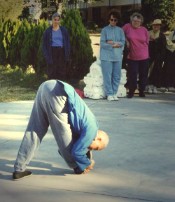 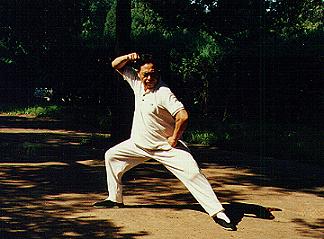
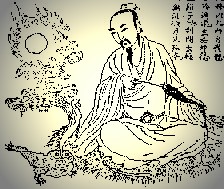
Standing
Meditation for Tai Chi
by Cynthia McMullen,
LMT
Meditation is often
one of the hardest parts of Tai Chi for beginning students to want
to learn. It can be a difficult thing to just step out of our fast
paced lives and all of a sudden go into a still and quiet place.
We’re not used to it, so the lack of being involved in external
stimulus can seem boring - at first. However this boredom
doesn’t last for long.
Meditation is also
one of the most important aspects of doing Tai Chi. Tai Chi has an
attitude of uncovering the "stillness within motion",
and it is only through meditation that we can realize this. It
grounds us, teaches us to center ourselves both emotionally and
physically, shows us how to Be in the moment, and builds up
tremendous leg strength from the inside out. It is through doing
meditation that our Tai Chi movements will be filled with
relaxation and that flowing, beautiful grace that it is known for.
What should one try
to make happen in meditation? Absolutely nothing. The idea is to
fully experience - in a very grounded way - whatever it is that
happens. Sometimes this will be nothing more than a serene sense
of peace and clarity. Other times experiences could include
visual, auditory, or tactile sensations. And energy flow within
ourselves can be a wonderful thing to allow and observe. There are
also physical changes in health and emotional attitudes that will
start to change and open. Each person will have their own, unique
range of experiences so it is best not to expect anything
specific, but remember to allow and observe what it is that
does happen.
The beginning
student should learn not to fear any sensations, thoughts, or
feelings experienced in meditation. The idea is to be able to
ground and center yourself, and from this position just allow and
observe the experience. By doing this there is no limit to what we
can learn about ourselves, why we think or act certain ways, the
depth to which our bodymindspirit is connected, and our
relationship to life.
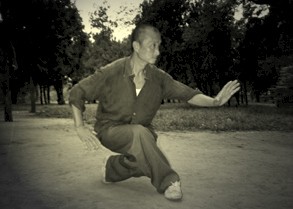
Standing meditation
is the most basic posture in Qi Gong, and Tai Chi is a form of Qi
Gong. Simple standing is usually done first to ground and center
ourselves, and begin to open and fill our energy centers. Standing
is then followed by some warm-up Qi Gong exercises. These
exercises build up our qi and harmonize the meridians. Finally we
do moving Tai Chi to flow the abundance of qi throughout our
bodies like the wind and water. The Taoist definition of health is
"the smooth, harmonious, abundant, and appropriate flow of qi".
Following are
step-by-step instructions for Standing Meditation. Ideally this
should be practiced 1 to 3 times daily. Start out by doing 5
minutes at a time, building up to 20 minutes, and not doing more
than 45 minutes at one time. At any time that you notice your
mind wandering, take it back to simply following your breath.
You will soon find why it is that advanced students and The
Masters do so much standing meditation.
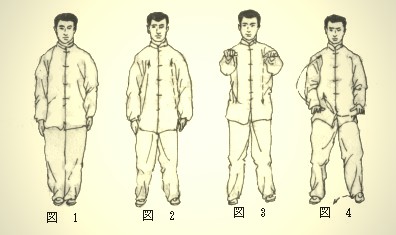
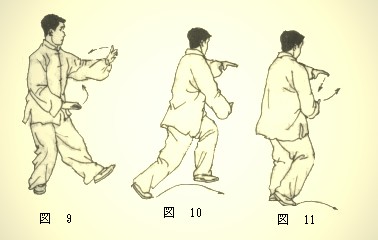
Standing in the Wu Ji
posture
1. Stand comfortably
with your feet shoulder width apart.
2. Make sure your toes
are pointed straight ahead.
3. There is a gentle,
relaxed bend to the knees and they tend to push lightly outwards as
opposed to collapsing inwards.
4. The pelvis is
tucked slightly forward so the lower spine is straight.
5. The shoulders are
loose and relaxed, not raised up, hands hang loosely at the sides.
6. The head is held up
as if suspended by a string.
7. Breathing is done
through the nose and is slow, soft, and deep.
8. Eyes are either
closed, or are slightly parted but not focused on anything.
Beginning the
meditation
-
Follow your breath
with your mind, feeling where it goes inside of you.
-
Slowly scan your
body from head to feet looking for any tension or discomfort. If
any is found, use the mind to gently guide the breath there and
as you exhale, imagine the tension flowing down and releasing
into the Earth, dispersing.
Focusing to activate
specific energy centers
-
Become aware of
your feet and their connection to the Earth. Imagine that you
are inhaling strong, clean energy from the Earth into the
Bubbling Well points of your feet, and exhaling used, turbid
energy back into the Earth. Do this for 8 to 36 breaths.
-
Next let the
energy from the Earth travel up the legs and into the lower dan
tien located beneath the navel. This is our center of inner
strength and power. Imagine that you are inhaling pure, healing
energy into your dan tien, letting it fill your entire lower
abdomen. Exhale, purging any unclean energy from this center. Do
this for 8 to 36 breaths.
-
Change the focus
of your mind to the heart center located in the middle of the
chest. This is our center of love and compassion. Imagine that
you are inhaling purified energy into the heart center. Exhale,
cleansing the heart and surrounding yourself with the feeling of
compassion. Do this for 8 to 36 breaths.
-
Change the focus
of your mind to the 3rd eye center located between the eyebrows
in the middle of the forehead. This is our center of higher
consciousness. Imagine that you are inhaling clear and focused
energy into the 3rd eye center. Exhale, cleansing the mind and
connecting with the consciousness of the Universe. Do this for 8
to 36 breaths.
-
Now bring the
focus of your mind back to the lower dan tien, below the navel.
Imagine a warm flow of energy filling this center. As you both
inhale and exhale, imagine a channel of energy extending upwards
from the dan tien to the heart center, and continuing up to the
3rd eye center. This connects our body, spirit, and mind.
Maintain this connection for 8 to 36 breaths.
-
Change the focus
of your mind to the palms of your hands. Imagine breathing into
the Lao Gong point at the center of your palms and also exhaling
from this point. Feel your hands filling and becoming surrounded
in warm qi. Do this for 8 to 36 breaths.
-
Finally, simply
stand and follow your breath. Allow yourself to feel the energy
flowing in and around your body. Do this until you feel
finished.
Variations
-
Seated
-
Embracing the one:
arms are circled with shoulders relaxed
-
Horse stance: feet
are beyond shoulder width apart
-
Embracing the one in
horse stance
Yu Yan's Diagram of the 12 Fire Phases:

The above 12 Hexagrams are the Taoist Alchemical road map into the esoteric meditation system of the macro orbital process. It traces the movement of the inner Qi, energy, or fire, up the central channel and gradually down again through the Receptive channel in the front of the body.
Notice how the yang line, _____, rises up through the yin lines - - . Knowing the 12 fire phases makes it possible for the Taoist master to guide the novice. Sometimes, in their haste beginners build up the fire too quickly, which can result in excessive manifestations of Qi in the form of hallucinations and spontaneous movement. Such phenomenon are mere manifestations of Qi transition from one stage of its movement into the next, but if the novice gets stuck in the phenomenon, the buildup of Qi can become very dangerous and may even exhaust the organic system of the body. A proper remedy must be sought out to heal the novice, allowing the Qi to flow properly.
The diagram comes from the Yiwai biezhuan (The separate transmission of the Book of Changes), written by Yu Yan in 1284. This work contains several cosmological diagrams, followed by passages drawn from the Book of Changes and commented on through quotations from the Zhouyi cantong qi.
Diagrams like this have a long history in China. They are used to show the correspondence between different ways of marking space and time, e.g., the directions, the twelve primary hexagrams (each associated with one month), the days of the moon cycle, the lunar mansions, and so on. In addition, each discipline is based on the laws of cosmology and uses these diagrams in different ways, e.g., for astronomical calculation or divination. In Chinese alchemy, the correspondences shown by these devices are used to establish the "fire phases" (huohou), i.e., the cycles of firing in external alchemy (waidan) and the cycles of the circulation of the primary components of the person in internal alchemy (neidan).
qian, i.e., Pure Yang [a hexagram]
kun, i.e., Pure Yin [a hexagram]
kan, i.e., Yang within Yin [both a trigram and a hexagram]
li, i.e., Yin within Yang [both a trigram and a hexagram]
Qian and kun represent the male and female principles that generate the cosmos, respectively. Kan and li contain those principles hidden within themselves once the cosmos is generated. These four trigrams and hexagrams are at the center of time and space and do not enter the cycles of time; therefore they are not shown in this or similar diagrams.
The twelve "sovereign hexagrams" in the fifth ring represent the rise and ascent of Yin and Yang. This movement, sometimes referred to as "ebb and flow" (xiaoxi), is apparent if the hexagrams are shown in the following way:

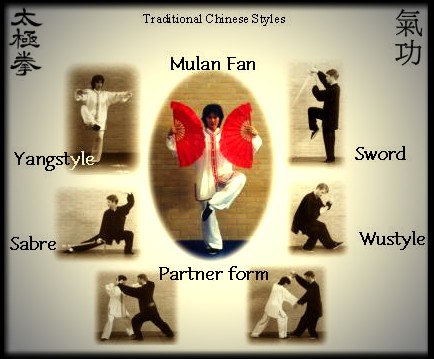
Qi Breathing :
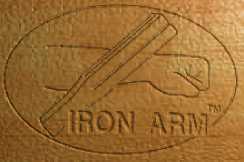

Daoist Breathing: This breathing involves you to pull in your stomach when you inhale and let in go out when you exhale. This will get Qi to flow out of the Tan Tien.
Belly Breathing: This exercise will allow you to bring Qi into your Tan Tien. When you inhale your stomach should expand out using the lower part of your lungs. When you exhale let the stomach return to its normal position.
Condensing Breathing: This exercise turns Qi into Jing (if you don’t know what Jing is see the “What is Qi” part of my web site) Visualize that you are only a skeleton. Center you attention to your arm bones. When you inhale visualize your Qi moving inward into the bone toward the marrow, like your bones are shrinking each time you inhale. When you exhale hold this visualization. Repeat this as much as you want. After a while you should feel a slight heat, tingling, cold, or vibrations in your arms, this is
Jing.
Qi Exercises to Generate more Qi
Qi: What is it? Qi, now where did that word come from?! Qi (pronounced “Chee”) is also known as chi, and to the Japanese it is called Ki. Chi is your life force, your energy. It is vital for without Qi you would be dead for there would be no life in you. Most people gather Qi without even knowing it; they gather it from the foods they eat and by sleeping. Others have discovered how to gather more Qi through meditation, martial arts like Tai Chi (Taiji), Qi Gong (Chi Kung), and through deep rhythmic breathing from the stomach. There are several other ways but I won’t list them all here. If one has a vast amount of Qi he will live longer than others who have not gathered extra Qi will. Daoists believed through meditation and Qi training one could become immortal. There are several legends of very old Tai Chi masters being able to fly because of this amazing energy. But aside from Qi there are a few other energies I will list them. Yi: Yi is intention. You will. You use Yi everyday to talk to eat as well as to use Qi. If one has a weak Yi there Jing will be weak for they cannot use Yi to direct the power. If one has a strong Yi and the ability to use Fa-Jing they could practically hit a person without touching them physically. Jing: Power. A punch is an ancient form of Jing while a Fa Jing (kinda like a “ki blast” from anime) is a lot more complex. Think of the body as an engine, Qi is the gasoline and Jing is the horsepower of the gasoline exploding into a more useful power. Shen: Shen is your spirit. You soul and mental force. Shen is god-like When one becomes advanced they use Shen instead of Qi and be able to create Jing and Yi from it alone. It is said that if one has a strong Shen as well as lots of Qi with enough Yi there soul will live forever and become a spirit. If one practices Qi movements and meditates (Tai Chi is also a big help) they can use all of the things above. The power is yours use it well and don’t abuse it or it will come back to haunt you. Qi also benefits you if you are a martial artist for yo will have more energy and your Qi may be able to warn you when your sparring partner is gonna through that next punch-kick combo.
Qi Exercise
Phoenix Spreads Its Wings and Dives
1. Stand with hands at side, one leg a half step in front of the other, visualize yourself as a phoenix.
2. Slowly raise up your arms until they are horizontal at your shoulder level, like a phoenix spreading its wings
.
3. Turn your hands outward, like a phoenix's wingtips.
4. Bend forward, with your arms behind you, like a phoenix swooping down.
5. Return to starting position and repeat as much as you want.
Effects: This exercise cultivates health and has the following effects on the practitioner. 1. Increased endurance and vigor 2. Built-up Resistance to Disease and cold weather 3. Strength 4. Clearer Skin 5. Spiritual progress and the cultivation of Wisdom
Where Should I Practice Qi Exercises
“Where should I practice Qi exercises?” You may ask. Well practice outside where the air is fresher and healthier (unless you live in LA….). I prefer to practice when I get home from school and usually go on until nightfall. I also find dusk one of my favorite times of the day. One should always wear comfortable clothing when practicing Qi exercises as well as practicing weapons forms (katas). I personally like to come home lift some weights, practice Qi Kung, and then work with my katana and yari, as well as my homemade Yumi (Japanese bow) with my handpicked Ya (arrows). One should practice whenever possible and try their best to do whatever it is they are doing. Also make sure you drink water before, after, and during any hard physical exercise…duh.
Healing with Qi
Qi Healing Techniques
Here are some techniques I have found that really help me when I get hurt.
Technique 1: Hot/Cold Healing
I do this when I have sore muscles, cramps, and …just plain old pain.
1:Imagine the place where the pain is located as a cold mass of cells, tissue, blood vessels, etc. Just imagine that everything there is cold.
2.Now imagine the Qi in you as a warm force. Move it to the place where it hurts with your Yi.
3.Have the heat warm the cold painful area, making it feel better and sending the pain away. Do this until you get the results you desire.
4.Remember to move the Qi back to the Tan Tien after you are done.
Technique 2: Internal Heater
I use this technique in the winter when I get cold. It is rather useful. I find that it works best when it is quiet and peaceful around me.
1. Imagine your Qi moving throughout your body.
2. Now imagine the Qi as a warm force
3. Now feel wave after wave of warmth wash over you
4. Once you have reached the desired effects send the Qi back to the Tan Tien.
Technique 3: Exhaling Pain
I perform this technique sometimes after a rigorous sparring match that I have received an injury in. For example I may have gotten a kick to my shin, after I get home if the pain is still there I do the following.
1. Imagine the pain as a black fog moving inside of you.
2. Now when you inhale visualize the air as a white fog going inside of you swirling around.
3. When you exhale imagine the black fog (pain) escaping your body through the pores in your skin.
4. When finished settle the Qi back into the Tan Tien via Yi.
Zhan Zhuang [Celestial Animals Zhan Zhuang
]
The Relaxed Dragon :
1. Stand with hands at your side, knees slightly bent, straight back.
2. Begin to visualize yourself as a dragon, with long whiskers and two big horns.
3. Stand like this for about 30 minutes. You might feel some heat in your hands after a while, this is quite normal, the Qi is trying to move to the dantian.
The Happy Dragon :
1. Stand facing east. Think of the dragon.
2. Put one hand round the belly, thumb in the belly button. Put the other hand over that.
3. Breathe to the belly, feeling it expand, filling with qi. Breathe slowly in until full- don't overdo it.
4. When full, lean foward 10-15 degrees, exhale, repeat nine times.
The Phoenix
1. Stand with hands at side, visualize yourself as a phoenix.
2. Slowly raise up your arms until they are horizontal at your shoulder level, like a phoenix spreading it's wings.
3. Turn your hands outward, like a phoenix's wingtips.
4. Stand like this for about fifteen minutes, feel the qi coming in through your palms.
Phoenix Takes Flight
1. Stand with back straight, one leg a half step in front of the other.
2. Slowly raise your arms in front of you, palms downward.
3. Bend foward, with your arms behind you, like a phoenix swooping down.
4. Return to starting position. Repeat nine times.
Well what are you waiting for, give these a shot!

|